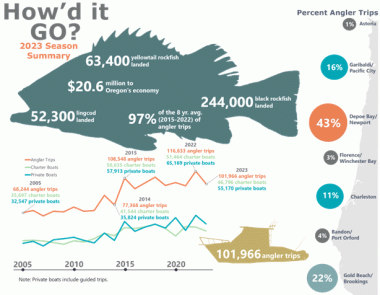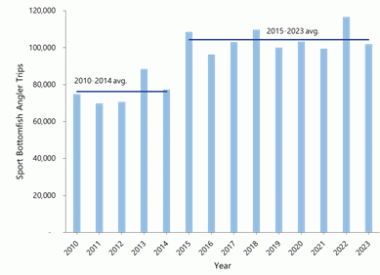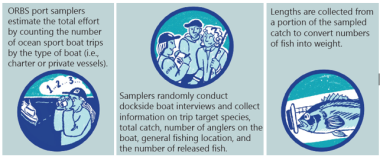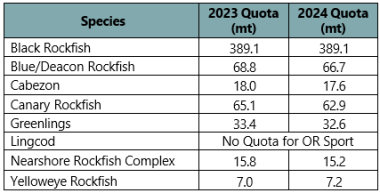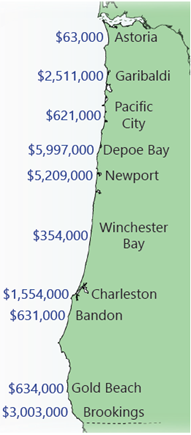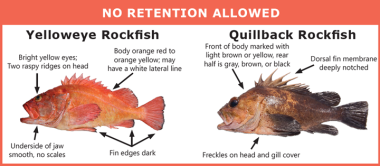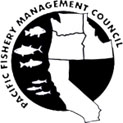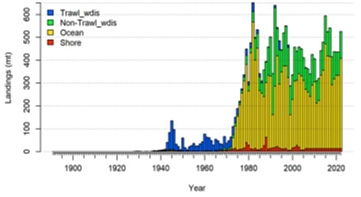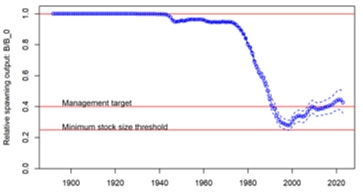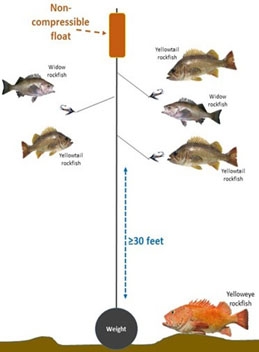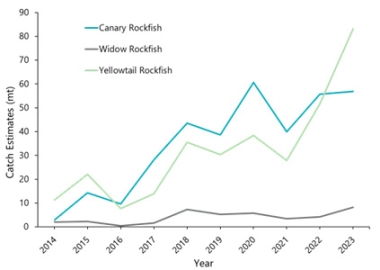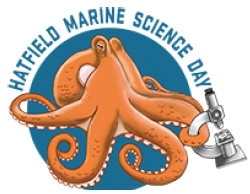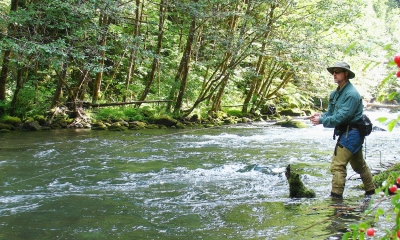
2023 Sport Bottomfish Newsletter
This newsletter provides a summary of Oregon's 2023 sport bottomfish fishery.

Table of contents
- 2023 season summary
- Fishery Monitoring
- Fishery Management
- Economic impact
- Bottomfish Identification
- Enforcement
- Allocation Changes for 2025
- Offshore Longleader Fishery
- Other updates and reminders
2023 season summary
Many species, many anglers
2023 was another popular year for the recreational bottomfish fishery, with 101,966 angler trips. This aligns with the current trend of higher effort that started in 2015, with an average of about 104,000 trips annually, making up 97 percent of the eight-year average (2015-2022). Prior to 2015, the average number of angler trips was around 76,300 trips annually.
Newport had the highest bottomfish effort of any Oregon port in 2023, with 23.1 percent of the total effort. Depoe Bay closely followed at 20.4 percent of the total effort. Brookings, Charleston, and Garibaldi had 17.3 percent, 11 percent, and 10.9 percent of the effort, respectively. All other ports had 5 percent or less of the total effort.
The recreational bottomfishfishery is made up of many different species. Black rockfish are the most popular species to catch off the Oregon coast, and in 2023 there were 244,000 or 279 metric tons (mt) of black rockfish landed from bottomfish trips.
There were 41,200 (30 mt) blue and deacon rockfishes landed. Longleader gear allowed anglers to have good success catching mid-water rockfish species with 63,400 (68 mt) yellowtail rockfish and 36,800 (43 mt) canary rockfish landed in the longleader gear and traditional bottomfish fisheries combined.
The catch of nearshore rockfish species (China and copper rockfishes) was 9,000 (11 mt). Anglers landed 52,300 (164 mt) lingcod and 4,100 (11 mt) cabezon.
The 2023 recreational bottomfish season generated approximately $20.6 million to Oregon's economy. See economic impact section for more information.
Monitoring Sport Bottomfish
How Does MRP Monitor the Sport Bottomfish Fishery?
ODFW's Marine Resources Program (MRP) has a fishery monitoring program to collect critical recreational bottomfish fishery information to inform management recommendations. Sampling is conducted by ODFW's Ocean Recreational Boat Survey (ORBS). MRP thanks all our samplers and the industry for remaining flexible and maintaining safety when collecting samples this past year.
For more information on ORBS and the Oregon recreational bottomfish fishery, please visit https://www.dfw.state.or.us/MRP/finfish/groundfish_sport/management.asp
Managing Sport Bottomfish
For most recreationally encountered species, there is a federal or state annual quota (Table 1), which is the amount of fish ODFW has to work with in setting season structures and bag limits. Exceeding quotas could lead to overfishing or have an impact on other fisheries. Note that lingcod does not currently have a quota in Oregon's recreational fishery because all fisheries combined (commercial, recreational, and tribal) are taking far less than the total allowable amount for the West Coast north of Cape Mendocino, CA.
The yelloweye rockfish bycatch quota is similar for 2023 and 2024. The yelloweye rockfish stock size has improved, though not enough to allow anglers to retain them. However, with their current level, some regulations that were designed to avoid yelloweye rockfish can be relaxed, such as the removal of the 40-fathom depth restriction during summer months.
The 2023 black rockfish quota was the same as the previous year and will be the same in 2024. However, changes are coming to this quota in 2025 following the results of a stock assessment completed in 2023. See allocation changes for 2025 section for more details.
Economic Impact
The recreational bottomfish fishery contributed approximately $20.6 million to Oregon's economy in 2023 through fishing-related costs such as gas, bait, gear, moorage, food, and hotels. This translates to about 360 full-time jobs.
Anglers fishing out of Newport and Depoe Bay had the most effort and the highest economic contribution with about $5.2 and $6 million, respectively (Figure 2). Anglers fishing out of Charleston, Garibaldi, and Brookings added between $1.5 and $3 million in each port.
Even in ports with less bottomfish effort, this fishery can have an important role in local economies, especially in the winter, spring and early summer before other fisheries, like salmon, begin.
Bottomfish Identification
Bottomfish, or groundfish, refers to several groups of fish that are generally associated with the ocean bottom. Off Oregon, this includes rockfish, flatfish, lingcod, cabezon, greenlings, sablefish, skates and rays, along with three species of sharks. With all of those species of fish, it can be difficult to know what you have caught.
The ODFW website has a variety of tools to help anglers with fish identification, including: rockfish identification tips, rockfish species information, flatfish species information, and "What can I keep and how many?". Additional fun resources available online are the popular "Common Bottomfish Species" and "Yelloweye Rockfish or Not?" quizzes that will test your identification skills. New for 2024 is the "Black Rockfish or Not?" quiz which will help perfect your skills in telling black rockfish apart from other species. This will be especially important starting in 2025. See allocation changes for 2025 section for more information.
Correctly identifying fish is important for following species harvest and size regulations and to accurately report species caught and released to the ODFW dockside sampler. It is also important to know your fish ID to avoid keeping an illegal fish. Quillback and yelloweye rockfishes are still prohibited. Some key characteristics are highlighted below.
Enforcement
Three agencies patrol on land and at sea to enforce marine fishing regulations: the Marine Fisheries Team from the Oregon State Police Fish and Wildlife Division, the U.S. Coast Guard, and the NOAA Fisheries Office of Law Enforcement. Rules keep fisheries sustainable, and enforcement is a key piece of the overall fisheries management.
Common issues seen are:
- fishing without a license
- not immediately tagging landed halibut
- exceeding the bag limit
- keeping prohibited species, such as yelloweye or quillback rockfishes
- fishing in closed areas, such as Marine Reserves or the Stonewall Bank Yelloweye Rockfish Conservation Area
Allocation Changes for 2025/2026
The Pacific Fishery Management Council (PFMC) adopted the preliminary annual catch limits (ACL) for all bottomfish species for 2025 and 2026 at its November 2023 meeting.
In 2025, the Oregon black rockfish ACL will be decreasing by about 33 percent. The stock is considered "healthy," but the estimate of the scale of the total biomass has decreased, prompting the decrease in allowable catch.
The coastwide (Washington, Oregon, and California) canary rockfish ACL will be decreasing by about 52 percent in 2025. These rockfish are in the "precautionary zone," meaning the current estimate biomass is below 40 percent of unfished. Therefore, reductions are necessary to get the stock back above that 40 percent level.
Both of these reductions are due to new assessments that say the scale of the overall biomass is lower than what was estimated during the previous assessments. See below for a summary of the most recent black rockfish stock assessment. For more information on the two assessments, visit: https://www.dfw.state.or.us/MRP/finfish/groundfish_sport/management.asp
The Council will finalize the allocations, season structures, and regulations for 2025 at its June 2024 meeting. The Oregon Fish and Wildlife Commission will be setting the 2025 season in December 2024.
Black Rockfish Stock Assessment
An Oregon black rockfish stock assessment (a model that uses fishery and survey information to create a population estimate) was completed in 2023, updating population status and overfishing limits from the previous 2015 assessment. The 2023 model includes new and updated data and is structured around using the first fishery independent black rockfish survey completed in 2021 along Oregon's entire coast.
This survey provides an estimate of the absolute biomass, anchoring the scale of the population in the model, which was a critical request following the previous assessment. The 2021 survey used a scientific fish finder with an underwater camera to effectively count black rockfish.
The 2023 assessment used a wide range of data from fisheries such as catch data as shown in Figure 3, including three ODFW historical catch reconstructions, and six indices of abundance which track the population level over time. These were from the commercial non-trawl fleet, the recreational fleet, the marine reserves hook and line survey, a tagging study of black rockfish off the central Oregon coast, and the 2021 coastwide black rockfish survey. Other important data included length and age data from commercial and recreational fisheries and surveys and updated reproductive information.
Results from the assessment model indicate that the stock size of black rockfish are at 45 percent which is just above the management target stock size of 40 percent (Figure 4). The stock status could drop below the management target without a reduction in catch prior to the next assessment.
|
|
|
Offshore Longleader Fishery
The offshore longleader fishery is a year-round opportunity to target midwater rockfish species (while avoiding benthic species such as yelloweye rockfish) outside of the 40-fathom regulatory line, using longleader gear only. For waypoints and maps of fathom lines, visit: myodfw.com/waypoints-sport-fishing.
The gear required consists of a fishing line and tackle configuration with a minimum of 30 feet of line between the terminal weight (sinker) and the lowest hook and a non-compressible float affixed above the top hook. See Figure 5. Lures must be less than 5 inches in length, and natural bait is prohibited.
The only species allowed are the following: yellowtail, widow, canary, greenstriped, redstripe, bocaccio, chilipepper, blue, deacon, and silvergray rockfishes. For more longleader fish ID, check out Offshore Longleader Species.
Lingcod, cabezon, kelp greenling, and other rockfish species not listed above are not allowed on the same trip. Bottomfish listed under the general marine species daily bag limit may be kept on a separate trip on the same day. A separate trip is when an angler returns to shore and offloads all fish prior to going out on another trip. Anglers may also return to shore, offload all longleader rockfish, and then go out on a separate trip for lingcod.
Anglers may combine an offshore longleader trip with an all-depth Pacific halibut trip. However, longleader fishing and regular bottomfish fishing cannot be combined on the same trip.
For more information, check out the Offshore longleader gear webpage
History of the Longleader Fishery
The offshore longleader fishery has been available year-round off the Oregon coast starting in 2018. Since then, there has been a significant increase in the catch of three midwater rockfish species commonly encountered with longleader gear: yellowtail, canary, and widow rockfishes.
This trend continued in 2023 with the highest catch of widow and yellowtail rockfishes in the last ten years and another high catch of canary rockfish (Figure 6). Canary rockfish is also commonly caught with traditional gear inside of the 40-fathom regulatory line and higher catch of this species is closely tied to the general marine species bag limit.
The longleader fishery provides anglers an opportunity to take home more fish. Since 2018, this fishery has had a 10-fish daily bag limit. In 2023, this limit was increased to 15-fish in March and then decreased back to 10-fish in September as catches were approaching quotas. In 2024, the longleader fishery will start the year with a 12-fish bag limit in the effort to hopefully avoid inseason changes.
Other Updates and Reminders
Rockfish Recompression
When a rockfish is brought to the surface, gas in the swim bladder expands. A fish suffering from barotrauma, an injury caused by a change in air pressure, will have a swollen body or stomach, esophagus protruding into its mouth, and/or bulging eyes. The expanded gas can make the fish too buoyant to swim back down to depth on their own.
Research shows that rockfish released near the depth of capture have a higher survival rate than those released at the surface. The Council incorporates this into management for rockfish species. For yelloweye rockfish, releasing at depth has helped prevent additional fishery restrictions and reduced the chance of a recreational fishery closure due to bycatch.
It is mandatory to have a descending device onboard the vessel when fishing for bottomfish or Pacific halibut and to use the descending device when releasing rockfish outside of the 30-fathom regulatory line.
Types of Descending Devices
A variety of commercially available and homemade devices are used. Find what works for your vessel and set up.
For additional information, see ODFW's Rockfish Recompression webpage
Hatfield's Marine Science Day, April 13, 2024
Hatfield's Marine Science Day is a combination open house and science fair featuring marine researchers affiliated with the Hatfield Marine Science Center.
Theme: Our Ocean, Our Future
Time: 10 a.m. - 4 p.m.
Exhibits: Throughout the day, you are welcome to visit marine science exhibitors who will share their work and answer questions.
The Hatfield Visitor Center will be open free of charge during this event!
This event is free and open to the public. All are welcome!
We are always interested in hearing from you about your fishery and the issues that are important to you.
Oregon Department of Fish and Wildlife,
Marine Resources Program
2040 SE Marine Science Dr., Newport, OR 97365
541-867-4741
Christian Heath
Halibut & Recreational Groundfish Project Leader
Christian.T.Heath@odfw.oregon.gov
Melanie Bukovec
Groundfish & Halibut Assistant Project Leader
Melanie.A.Bukovec@odfw.oregon.gov

